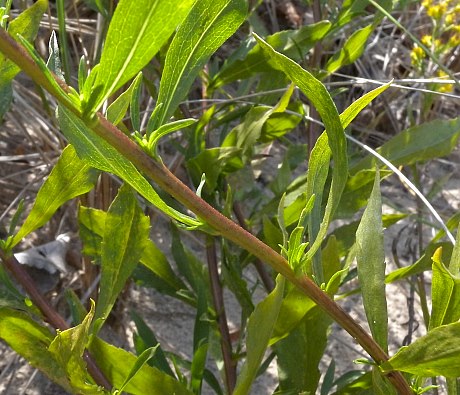
The central stem terminates in a narrow panicle of flowerheads about 3-10" long and 1-2½" across. In each panicle, the flowerheads bloom from top to bottom. The panicle is sparingly branched; the branches and peduncles of the panicle are light green, narrowly terete, and often slightly pubescent and resinous. Small leafy bracts (up to 1" long & 1/8" across) occur along the branches of the panicle, including the central axis. The flowerheads have relatively long peduncles (¼-½ in length) that equal or exceed the length of individual flowerheads. Each flowerhead is about 1/6" (4-5 mm.) across and 1/4" (7 mm.) long, consisting of 7-10 yellow ray florets and slightly more disk florets that are golden yellow. Each disk floret consists of a narrow tubular corolla with 5 spreading lobes. Both ray and disk florets are fertile and capable of producing achenes. The base of each flowerhead has narrow floral bracts (phyllaries) in 2-3 overlapping series; they are light green or pale yellowish green, more or less oblong in shape, hairless, and slightly resinous. The blooming period occurs from mid-summer to early fall and lasts about 1-2 months. During the fall, the florets are replaced by small bullet-shaped achenes (2-3 mm. in length) with small tufts of hair; the achenes are sparsely to moderately hairy. They are distributed by the wind. The root system consists of a small caudex with fibrous roots and short rhizomes. Vegetative offsets are occasionally formed.
Cultivation: The preference is full sun, mesic to dry conditions, and very sandy soil. Rocky soil is also tolerated.

Range & Habitat: According to available records at herbariums, Dune Goldenrod does not occur in Illinois. However, it has been found in all three counties of Indiana that border Lake Michigan, where it is listed as a 'threatened' plant. Because it can be found across the state border in Indiana, it is possible that Dune Goldenrod exists, or at one time existed, as a rare plant in Illinois along the Lake Michigan shoreline. Outside of the state, habitats consist of sand dunes, drier areas of beaches, and rocky shorelines along Lake Michigan and Lake Huron. This wildflower is usually found on semi-stabilized sand dunes that are several hundred feet away from the lake shoreline; it can be located on the lower slope, upper slope, or the flattened top of a dune, usually in proximity to Beach Grass (Ammophila breviligulata).
Faunal Associations: The following information applies to Solidago spp. (goldenrods) in general as very little floral-faunal information is available about Dune Goldenrod specifically. The flowerheads are visited by a wide variety of insects, including long-tongued bees, short-tongued bees, wasps, flies, small- to medium-sized butterflies, and beetles. Several Andrenid bees (Andrena spp.) and a Plasterer bee (Colletes simulans armata) are oligolectic visitors of the flowerheads: their larvae require goldenrod pollen for proper growth and development. Other insects feed on the plant or flower tissues of goldenrods; these species include the caterpillars of Schinia nundina (Goldenrod Flower Moth) and many other moths, several species of aphids (mostly Uroleucon spp.), the leafhoppers Neokolla hieroglyphica and Scaphytopius acutus, the treehopper Campylenchia latipes, Corythucha marmorata (Chrysanthemum Lace Bug), Homaemus aeneifrons aeneifrons and other stink bugs, Lopidea media (Goldenrod Plant Bug) and other plant bugs, several leaf beetles (Microrhopala spp., Ophraella spp., Trirhabda spp., & others), Eurosta solidaginis (Goldenrod Gall Fly), and grasshoppers that consume broad-leaved plants. Among vertebrate animals, the seeds are eaten by the Eastern Goldfinch, Pine Siskin, and other songbirds, while the leaves and flowerheads are eaten by the Greater Prairie Chicken. White-Tailed Deer and Cottontail Rabbits feed on the foliage of goldenrods occasionally.
Photographic Location: The upper slope of a large sand dune near Lake Michigan at Indiana Dunes State Park in NW Indiana.

Comments: This interesting goldenrod is one variety of a highly variable species, Solidago simplex, which has a total of about 8 varieties that are currently recognized. Most of these varieties, like Dune Goldenrod, are habitat specialists with restricted ranges. Therefore, Dune Goldenrod is the only variety that one is likely to encounter in Illinois or one of the neighboring states. Another species, Solidago speciosa (Showy Goldenrod), can be found in sandy savannas and stabilized foredunes near Lake Michigan, and it is possible to confuse depauperate specimens of this species with Dune Goldenrod. However, Showy Goldenrod has a more branched panicle with shorter peduncles, its cauline leaves vary less in size as they ascend the central stem, and its achenes are hairless. Another species, Solidago uliginosa (Bog Goldenrod), also has an appearance that is similar to Dune Goldenrod, but it inhabits wetlands. Bog Goldenrod has fewer leaves along its stems and its floral bracts (phyllaries) are yellow, rather than green or yellowish green. Other scientific names of Dune Goldenrod include the following: Solidago racemosa gillmanii, Solidago spathulata gillmanii, Solidago gillmanii, and Solidago deamii.